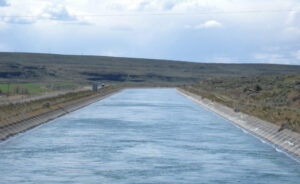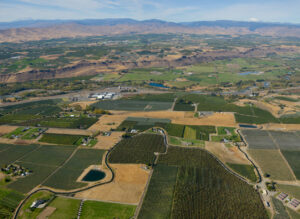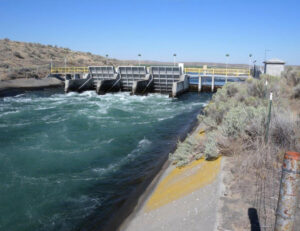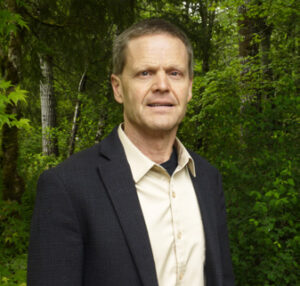The Washington State Water Resources Association (WSWRA) advocates for water districts, including those of the Bureau of Reclamation’s Columbia Basin and Yakima Projects, to ensure that they can continue to deliver water to their customers. In this interview, Irrigation Leader speaks with the association’s new executive director, John Stuhlmiller, a former lobbyist for the Farm Bureau, about what he wants to achieve in his new position.
Irrigation Leader: Please tell us about your background and how you came to be in your current position.
John Stuhlmiller: I am a farm kid from eastern Washington. I grew up on a dryland farm just west of Spokane. I went to college and did an internship with the state legislature, then stayed to work on natural resources issues. After 20 years, I took a position lobbying for the Farm Bureau. About 10 years ago, I took over as the chief executive of the Farm Bureau, and I just left the organization in April.

Irrigation Leader: At the legislature, you worked on establishing the Office of Columbia River. Would you tell us about your experience doing that?
John Stuhlmiller: One of the most exciting moments in my career was working with legislators to craft the landmark legislation establishing the Office of Columbia River. We were experiencing a very divisive political climate in water policy at that time. An intense public battle over water use and environmental protection was boiling. Lawsuits were being filed, and hardened political positions were creating gridlock. We created a path that brought the environmental community, tribes, and a host of other entities to the center to ensure that future water supply development would be balanced with environmental protection. We were able to turn the Department of Ecology’s mindset from stopping the development of new water supplies to aggressively pursuing new water. This new direction was only possible because we worked to find an out-of-the-box solution. We proposed allocating two-thirds of all new water to out-of-stream use and one-third to in-stream use. This creativity enabled us to break the gridlock.
Irrigation Leader: For any of our readers who are not familiar with WSWRA, would you introduce the organization and its main activities?
John Stuhlmiller: The association is made up of irrigation districts and water districts in Washington. The largest members are the districts found within Reclamation’s Columbia Basin and Yakima Projects. The organization provides a forum for districts that have the same operational challenges and threats to band together and speak with one voice. Our goal is to make sure that public policy moves in the right direction so that districts can continue to deliver water to their customers.
Irrigation Leader: What are the top things that you’re looking forward to tackling in your new position as executive director?

John Stuhlmiller: I will strive to ensure our members get value for their membership. Each district needs to be informed about public policy issues, and they need to be able to express their unique operational concerns and challenges with their peers so that they can develop a strong, unified voice for advocacy. With this combined voice, they can seek solutions with agencies or legislators. I will work with our team to champion our members’ perspectives and collective needs to help ensure they can continue to serve their customers.
Irrigation Leader: What are some of the top issues for the association today?
John Stuhlmiller: Irrigation districts are faced with many challenges. The task of keeping infrastructure intact and operational is a full-time job. This job is made more challenging as new regulations are proposed. There is constant pressure to operate more efficiently and with even more environmental protections. Currently, districts are facing the potential loss of an important algaecide used to keep canals and ditches free of weeds and algae. Our job is to help policymakers understand how products are used in a safe fashion before they make a decision that could irreparably harm districts and their operations.
Irrigation Leader: How will your extensive experience at the state legislature help you in your new position at the association?
John Stuhlmiller: My public policy work at the federal, state, and local levels has given me insight into how the process works, who the players are, and how to innovatively work on issues. I will use my experience to help our members find new ways to successfully present their concerns and issues.
Irrigation Leader: To what degree is the association active at the federal level with organizations like Reclamation?

John Stuhlmiller: We are very active with federal partners, especially in the Yakima and Columbia River basins. The irrigation districts there are Reclamation projects, so the managers of those districts constantly interact with the bureau. This interaction is not limited to Reclamation, however, since the U.S. Army Corps of Engineers, the U.S. Environmental Protection Agency, and a host of state agencies are involved in river operations and other regulatory activities.
Irrigation Leader: Are there any changes that you’d like to see in how those federal and state agencies run?

John Stuhlmiller: We are always seeking more efficient and timely decisionmaking to ensure that districts can deliver water efficiently and cost effectively. There are bureaucracies involved, and it is hard for agencies to be nimble. Part of WSWRA’s job is to help guide those agencies into more timely action.
Irrigation Leader: What is your message to the state legislature?
John Stuhlmiller: Water and irrigation districts play a vital role in keeping agriculture productive throughout the state of Washington. We need to make sure that water continues to be available, because it is the lifeblood of a sustainable and plentiful food supply.
Irrigation Leader: What is your vision for the future?
John Stuhlmiller: We hope to deliver a clear message at the federal and state levels. We want to maintain clear communication so we can work collaboratively with all agencies and stakeholders. We are always striving to strengthen relationships and keep conversations going to try to avoid surprises and hopefully to ensure better public policy.
John Stuhlmiller is the executive director of the Washington State Water Resources Association. He can be contacted at jstuhlmiller@wswra.org.

